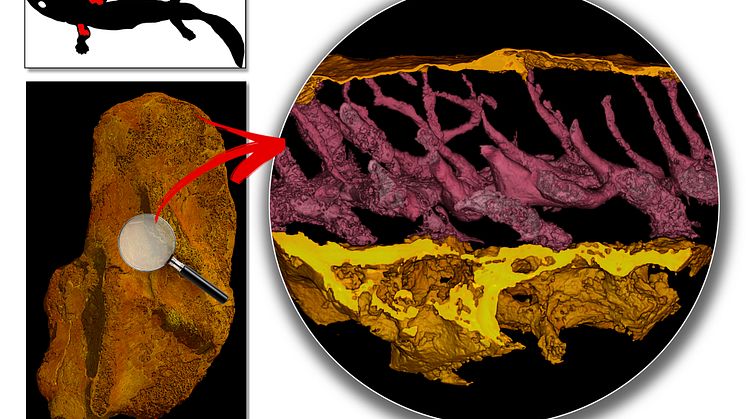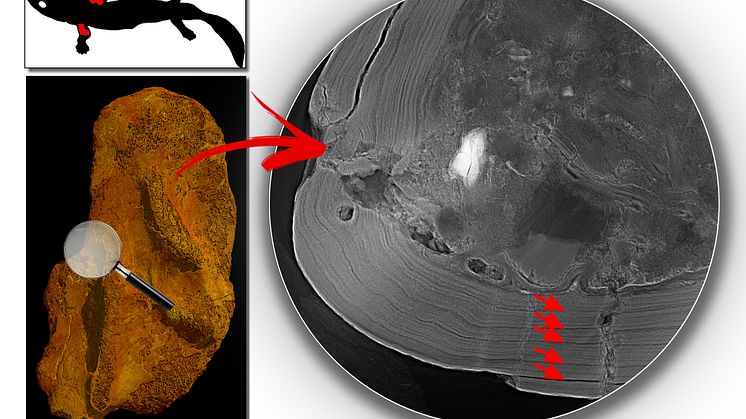Press release -
Life history of the 360 million-year-old Acanthostega rewrites the tetrapod move on land
This week in the journal Nature, an international team of researchers shows that fossils of the 360 million-year-old tetrapod Acanthostega, one of the iconic transitional forms between fishes and land animals, are not grown-ups but all juveniles. This conclusion, which is based on high-resolution synchrotron X-ray scans of fossil limb bones, sheds new light on the life cycle of Acanthostega and the so-called conquest of land by tetrapods.
Early tetrapods of the Devonian period (419-359 million years ago) were the earliest vertebrate animals that ventured onto land. The move from water to land must have affected every aspect of the biology of these animals, but until now there has been no serious attempt to investigate their life histories - how long they lived, whether they had an aquatic juvenile stage, and so on. Well-preserved skeletons are rare and it has simply been assumed that they represent adults.
The single richest locality for Devonian tetrapods is a so-called mass-death deposit of Acanthostega, discovered in 1987 in Greenland by Jennifer Clack, one of the authors of the study, where dozens of skeletons lie packed together like sardines in a tin. It looks like the tetrapods all died together when a small stream within an “inland delta” (like the modern Okavango in Botswana) dried out.
The team from Uppsala University in Sweden, the European Synchrotron Radiation Facility (ESRF) in France and the University of Cambridge in the UK decided to look at the life history of these fossils by investigating the internal structure of their humeri (upper arm bones).
‘Using the tremendous power of synchrotron X-rays, we were able to access microscopic details in these dense specimens as on real histological slices, but without damaging these unique fossils’, says Paul Tafforeau from the ESRF.
The microscopic structures in the bones of these fossil tetrapods are almost perfectly preserved.
‘Like a growing tree, a limb bone is marked by seasonal rhythms and lays down annual growth rings. These growth rings, which can be seen in both fossil and living tetrapods, are informative about the development and age of the individual’, says Sophie Sanchez, the lead author of the publication, working at Uppsala University and the ESRF.
The powerful X-ray beam of the ESRF revealed that all studied fossils of Acanthostega were immature individuals, even though they were at least six years old and probably older. Their growth had not yet begun to slow down as it does at sexual maturity. In addition, the researchers showed that Acanthostega’s foreleg remained cartilaginous until late during its development. In contrast to bone, cartilage is a non-mineralised tissue, elastic and far too weak to allow the forelegs to sustain the weight of the animal’s body out of the water.
‘This suggests that the Acanthostega mass-death deposit represents a school of aquatic juveniles that included few or no adults’, says Per Ahlberg from Uppsala University.
So where were the adult Acanthostega living? This remains to be discovered.
The tetrapod move onto land was arguably one of the most radical adaptive shifts in vertebrate evolutionary history.
‘Our study provides a first glimpse of the life-history traits of an early tetrapod. We plan to undertake a more complete survey of early-tetrapod life histories which should have a significant impact on theories about tetrapod terrestrialisation depicted in all textbooks’, concludes Sophie Sanchez.
For more information, please contact: Sophie Sanchez, E-mail: sophie.sanchez@ebc.uu.se Phone : +46 (0)18 471 2677
Sanchez et al (2016) Life history of the stem tetrapod Acanthostega revealed by synchrotron microtomography, Nature, Advance Online Publication, DOI: 10.1038/nature19354
Topics
Uppsala University -- quality, knowledge, and creativity since 1477
World-class research and outstanding education of global benefit to society, business, and culture.
Uppsala University is one of northern Europe's highest ranked academic institutions. www.uu.se


